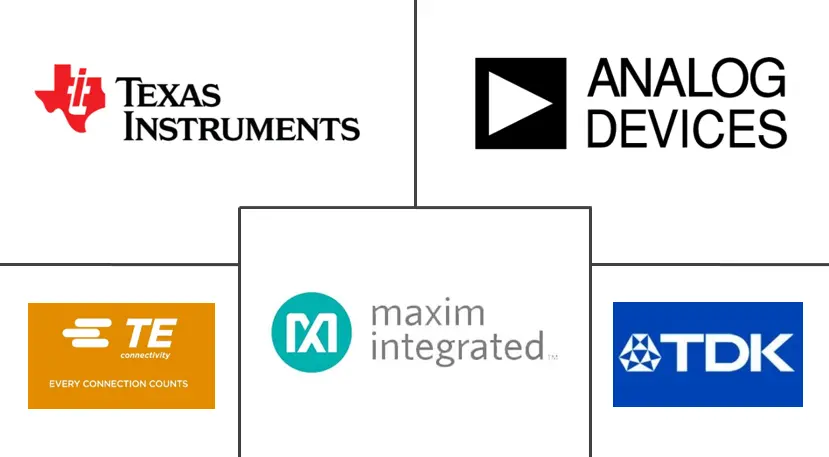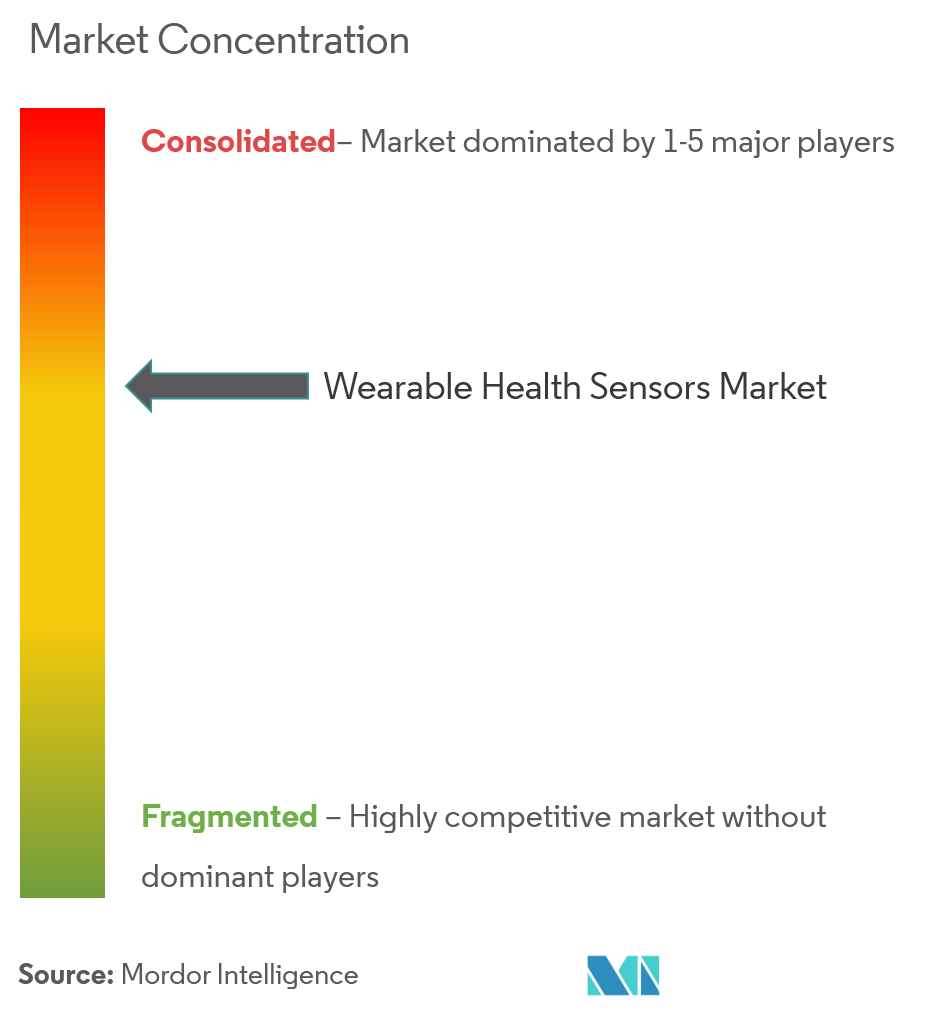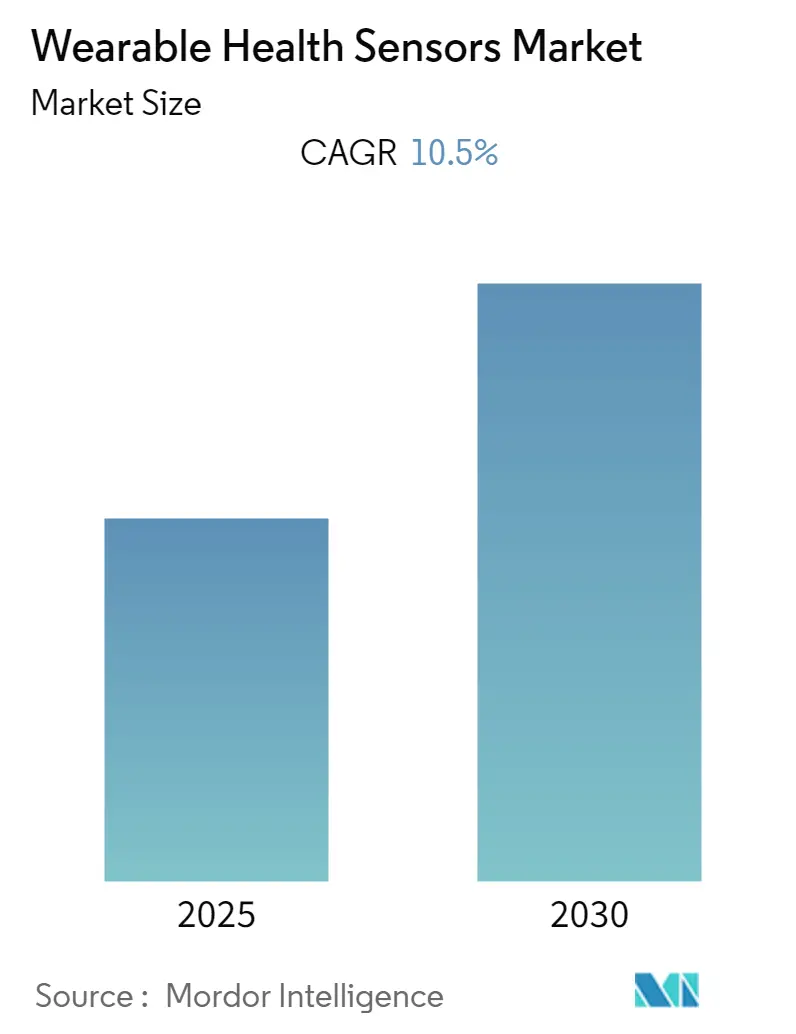
Wearable Health Sensors Market Analysis
The Wearable Health Sensors Market is expected to register a CAGR of 10.5% during the forecast period.
- Leveraging wireless connectivity, powerful application processing, and smartphone storage capabilities, wearable sensors are finding new use cases, such as remote patient monitoring, where the patient's motion data analysis can be sent directly to the physician, which may further boost the market growth.
- Furthermore, In August 2022, engineers from the Massachusetts Institute of Technology developed wearable wireless sensors without the Bluetooth module housed in them. It is a wearable sensor that transmits wirelessly without onboard chips or batteries. This project opens an avenue toward chip-free wireless sensors. The new sensor, called - 'e-skin', is an ultrathin semiconductor film of piezoelectric material which adheres to the skin, sensing the body's vibration. It also does not require any power source.
- Technological advances in health sensor devices can assist clinicians in identifying patients at high risk of disease, which is expected to drive market growth. For instance, in January 2021, Biosticker, a highly advanced on-body sensor that allows effortless monitoring of vital signs and actionable insights, was provided to clinicians from patients in hospitals or home care settings, creating a unique opportunity for the early detection of complications.
- The increased level of awareness concerning healthcare has created an emerging need for smart health sensor technologies and monitoring devices that can sense and provide users feedback about their health status for increased safety. Further, in February 2021, engineers at the University of California, San Diego, developed a soft, elastic skin patch that can be worn around the neck. It measures the wearer's glucose, lactate, alcohol, and caffeine levels while monitoring blood pressure and heart rate. Additionally, it analyzes several biochemical levels and cardiovascular signs in the human body.
- The key factors in the proliferation of wearable sensors in healthcare are the availability of low-cost MEMS technologies, low-power microcontrollers, and efficient and reliable telemetry modules. Furthermore, Honeywell offers the 26PC SMT (Surface Mount Technology) Series pressure sensor. This small, low-cost, high-value pressure sensing solution replaces the need of the healthcare professional to place a stethoscope under the pressure cuff, to hear the noise of the rushing blood.
- Machine learning and AI capabilities are taking healthcare professionals' skills to the next level, especially in the current healthcare industry. In support of this, IoT-compatible wearable sensors are also witnessing a decline in pricing, which leads to manufacturers offering wearable devices at a more affordable rate, thus encouraging various industries to adopt products catered to their systems and operations. Additionally, there has been a significant increase in the number of wearable devices sold over the past few years.
- Furthermore, as technical devices require continuous R&D for various features, industry players' ongoing technological advances are fueling the development of smartwatches. Amazfit Bip U Pro and BOAT Xplorer were launched in India in April 2021. PPG bio-tracking optical sensors in smartwatches continuously monitor heart rate.
- Further, the global population is driving a trend toward home healthcare. The COVID-19 pandemic accelerated the use of remote patient monitoring and continuous diagnostic devices, including medical wearables. Wearable sensors help monitor a person's health, as they constantly measure their blood pressure, glucose concentrations, heart rate, and other activities. Moreover, in February 2021, Health Canada approved Bactiguard's urinary catheter with temperature sensor for infection prevention through an Interim Order. This approval was driven by COVID-19, as Bactiguard's catheters tend to reduce the risk of secondary infections for critically ill patients.
Wearable Health Sensors Market Trends
Healthcare Industry Holds a Dominant Share in Wearable Health Sensors Market
- The increased level of awareness concerning healthcare has created an emerging need for smart sensor technologies and monitoring devices that are able to sense and provide feedback to users about their health status for increased safety. Miniaturization of health sensors will lead to significant benefits in their application since smaller versions of sensors are more flexible, and they can be embedded in a variety of devices to obtain real-time information.
- For instance, in May 2022, MovanoInc., a medical technology start-up, started using radiofrequency technology to develop a patented system-on-chip (SoC) platform for a range of sensors to be incorporated into future medical wearables. The company has started the beta testing of a prototype that will be able to perform blood and glucose sensing.
- Further, various healthcare monitoring systems use different types of sensors developed to monitor specific body parameters of the patient continuously. Different biosensors available to measure heart rate, body oxygen level, and temperature are attached to the Arduino Nano board, and recorded signals are sent to the server using Node MCU ESP8266 wireless communication.
- For instance, in August 2021, Abbott reported data from the GUIDE-HF clinical trial, where its CardioMEMSHF System reduced mortality in New York Heart Association (NYHA) Class II, III, and IV heart failure patients. A small implantable sensor, CardioMEMS, is designed to measure and track pulmonary artery pressure and heart rate wirelessly. These pressure changes suggest deteriorating heart failure even before patients feel symptoms.
- Moreover, wearable devices play a significant role in healthcare analytics, where the data collected from the device can be used to analyze and diagnose disease. From headsets that measure brainwaves to clothes that include sensing devices, BP monitors, etc., these have taken personal health monitoring to a new level. Furthermore, in September 2021, Rockley Photonics announced that the company had expanded the range of possible applications for its non-invasive biomarker sensing technology to support a wider range of medical equipment and devices.
- Further, pressure sensors hold significant importance in respiratory monitoring and are used in ventilators to monitor patients' breathing. Pressure sensors are critical components in ventilators and provide necessary breathing assistance to patients battling COVID-19. MEMS-based pressure sensors contribute to advancing and improving conventional ventilators to avoid various injuries during the ventilation process.
- Additionally, in July 2022, Inspira Technologies OXY B.H.N Ltd, a respiratory support technology company, announced the development of the HYLA blood sensor. Inspira's non-invasive optical blood sensor is designed to perform real-time and continuous blood monitoring to alert physicians of immediate changes in a patient's clinical condition without taking actual blood samples.
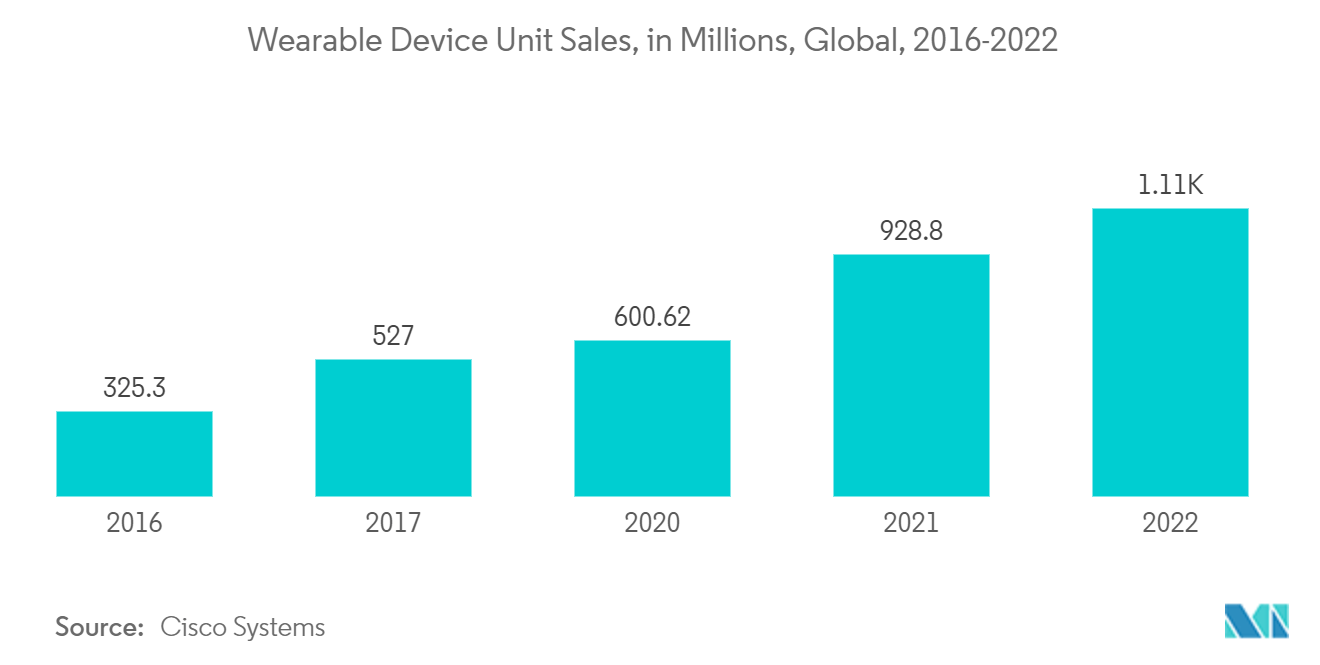
Europe holds Significant Market Share
- The significant growth in Europe's Wearable Health Sensors market is being stimulated by the reduced costs of sensors and the increasing adoption of smartphones. The growing consciousness among consumers regarding fitness and the easy availability of applications that track and monitor fitness are driving the market ahead.
- According to the GSMA, 474 million people in Europe (86% of the population) subscribed to mobile services in 2021, with this figure expected to rise to 480 million by 2025. Such developments in consumer electronics will further drive market growth.
- With the increasing trend of wearable gadgets in the healthcare and medical industry, companies in the European market have been launching new and innovative sensors for such applications.
- For instance, in July 2021, Rockley Photonics, a global silicon photonics technology company, launched its complete full-stack, "clinic-on-the-wrist" digital health sensor system. Rockley's sensor module and associated reference designs for consumer wearable devices could monitor multiple biomarkers, including blood pressure, core body temperature, alcohol, lactate, body hydration, and glucose trends.
- Further, expanding wireless technology in Europe has considerably improved sensors' communication capabilities. The miniaturization, coupled with the reduction in power requirement of sensors, has enabled their integration into various devices in an aesthetic manner, thus generating significant buzz among the younger users who are seeking a combination of technology and fashion.
- For instance, 8sense is a wearable start-up from Germany that makes the world's first smart back sensor with a virtual coach. The 8sense system regularly gives feedback on the user's posture, combining position and movement analysis with real-time interaction and training. Designed to enhance and protect health and productivity, this attachable coach helps to sit more actively and informs about actual fitness levels in the office.
- The market is expected to register high growth in Western European countries, owing to the increasing aging population. The use of wearables to monitor and track their well-being creates a significant demand for wearable health sensors. In August 2021, Masimo announced the CE marking and launch in western Europe of Masimo SafetyNet Alert, an arterial blood oxygen saturation monitoring and alert system designed for the home. Masimo SafetyNet Alert features a Signal Extraction Technology wearable fingertip pulse oximetry sensor that communicates wirelessly to an accompanying Home Medical Hub and smartphone app.
- Healthcare accounts for a significant chunk of the wearable sensors market, particularly in developed markets like the United Kingdom and France. Increasing applications in the fields of Defense and Infotainment are expected to enhance the market. The development of novel applications is the primary trend.
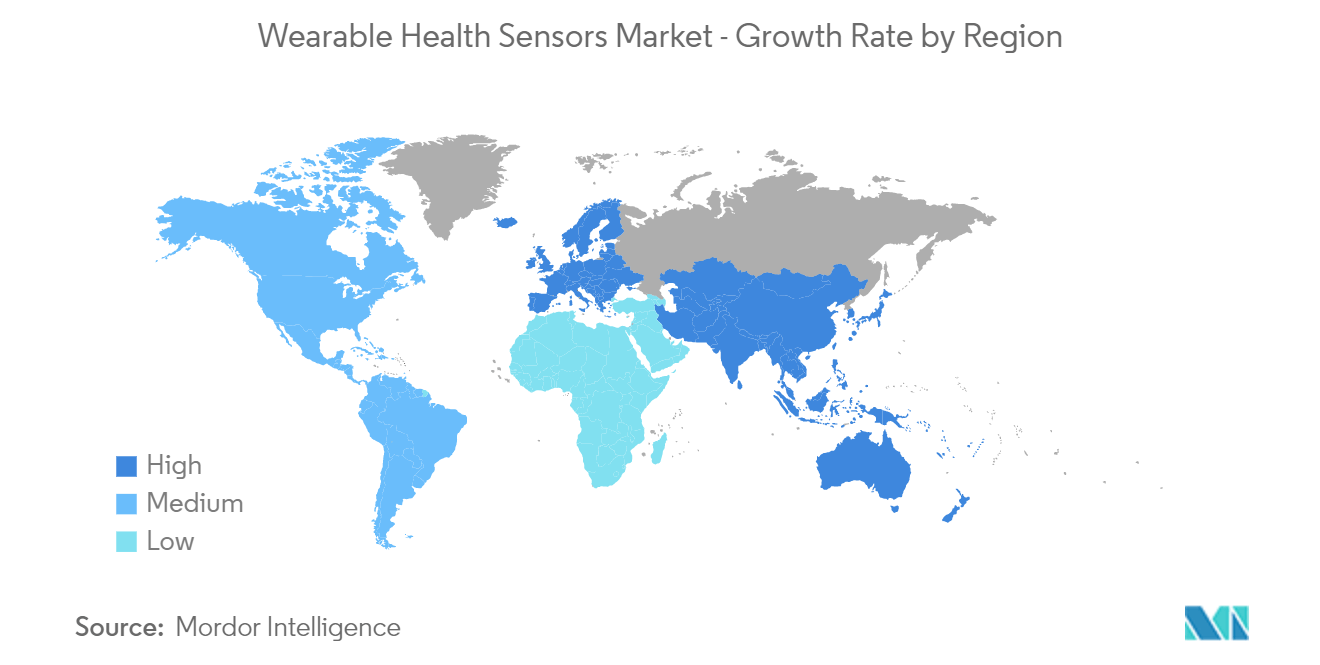
Wearable Health Sensors Industry Overview
The wearable health sensors market is moderately competitive and consists of several major players. In terms of market share, few significant players currently dominate the market. It also has a lucrative growth rate, with key players investing in R&D to strengthen their product portfolios by launching novel products and technologically upgrading their existing products. Players' focus on manufacturing patent products is expected to fuel market competition.
In February 2022, Abbott Laboratories, a US-based medical device company, developed consumer bio wearables called Lingo that can track key body signals to help users better understand their overall health and take steps to improve it. It may allow biohackers to use a continuous stream of data rather than sporadic finger-prick tests, urine samples, and breath readings.
In December 2021, NextNav, a company specializing in next-generation GPS, teamed up with Bosch Sensortec. This company specializes in sensing solutions for consumer electronics, enabling more exact vertical placement in barometric pressure sensors. The NextNav Certified program will put Bosch Sensortec's barometric pressure sensors through rigorous testing to ensure that their accuracy and performance exceed strict standards across various application scenarios.
Wearable Health Sensors Market Leaders
-
TE Connectivity Ltd.
-
Analog Devices Inc.
-
TDK Corporation
-
Texas Instruments Incorporated
-
Maxim Integrated Products Inc.
- *Disclaimer: Major Players sorted in no particular order
Wearable Health Sensors Market News
- June 2022 : Nitto Denko Corporation agreed to acquire Bend Labs, Inc. In line with this acquisition, Bend merged into the Nitto Group from June 1, 2022 to continue its business operations as Nitto Bend Technologies. As a result of this merger agreement, Bend's sensor device technologies were combined with Nitto's strengths for developing a next-generation technologies and products portfolio and new businesses utilizing sensor-acquired data.
- February 2022 : Abbott announced that the US Food and Drug Administration (FDA) had approved an expanded indication for its Cardio MEMS HF System to support the care of people with heart failure. As a result, an additional 1.2 million US patients are now eligible to benefit from advanced monitoring with the company's sensor, which marks a significant increase over the current addressable population. The sensor provides an early warning system enabling doctors to protect against worsening heart failure.
Wearable Health Sensors Industry Segmentation
Sensors used for tracking and finding information related to fitness, health, location, etc., that are integrated in a wearable device or technology are called wearable sensors. These sensors are integrated into accessories, wearables, cloth, etc., using wireless devices that allow biological and physiological sensing to measure, monitor, and diagnose blood pressure, heart rate, and other metabolic activities. The studied market is segmented by Types, such as Pressure Sensors, Temperature Sensors, and Position Sensors, among different End-user Industries such as Healthcare, Consumer Electronics, and Sports/Fitness in various geographies.
The market sizes and forecasts are provided in terms of value (USD million) for all the above segments. The impact of COVID-19 on the market and impacted segments are also covered under the scope of the study. Further, the disruption of the factors affecting the market's expansion in the near future has been covered in the study regarding drivers and restraints.
| By Type | Pressure Sensor |
| Temperature Sensor | |
| Position Sensor | |
| Other Types | |
| By End User Industry | Healthcare |
| Consumer Electronic | |
| Sports/Fitness | |
| Other End User Industries | |
| By Geography | Asia Pacific |
| Europe | |
| Latin America | |
| Middle East and Africa | |
| North America |
Wearable Health Sensors Market Research FAQs
What is the current Wearable Health Sensors Market size?
The Wearable Health Sensors Market is projected to register a CAGR of 10.5% during the forecast period (2025-2030)
Who are the key players in Wearable Health Sensors Market?
TE Connectivity Ltd., Analog Devices Inc., TDK Corporation, Texas Instruments Incorporated and Maxim Integrated Products Inc. are the major companies operating in the Wearable Health Sensors Market.
Which is the fastest growing region in Wearable Health Sensors Market?
Asia Pacific is estimated to grow at the highest CAGR over the forecast period (2025-2030).
Which region has the biggest share in Wearable Health Sensors Market?
In 2025, the Europe accounts for the largest market share in Wearable Health Sensors Market.
What years does this Wearable Health Sensors Market cover?
The report covers the Wearable Health Sensors Market historical market size for years: 2019, 2020, 2021, 2022, 2023 and 2024. The report also forecasts the Wearable Health Sensors Market size for years: 2025, 2026, 2027, 2028, 2029 and 2030.
Our Best Selling Reports
Wearable Health Sensors Industry Report
Statistics for the 2025 Wearable Health Sensors market share, size and revenue growth rate, created by Mordor Intelligence™ Industry Reports. Wearable Health Sensors analysis includes a market forecast outlook for 2025 to 2030 and historical overview. Get a sample of this industry analysis as a free report PDF download.

